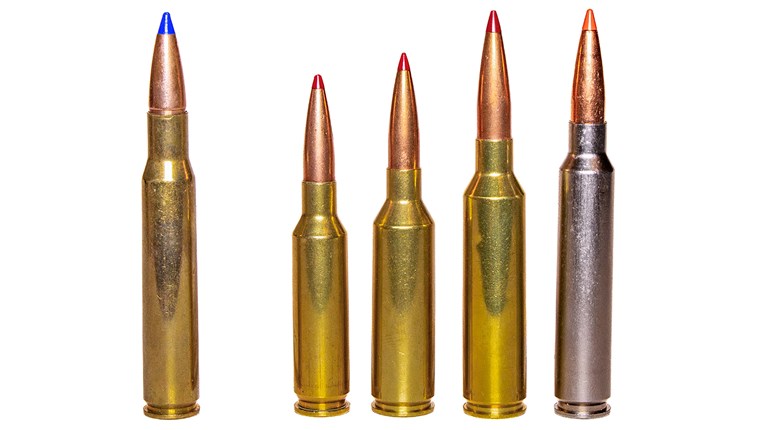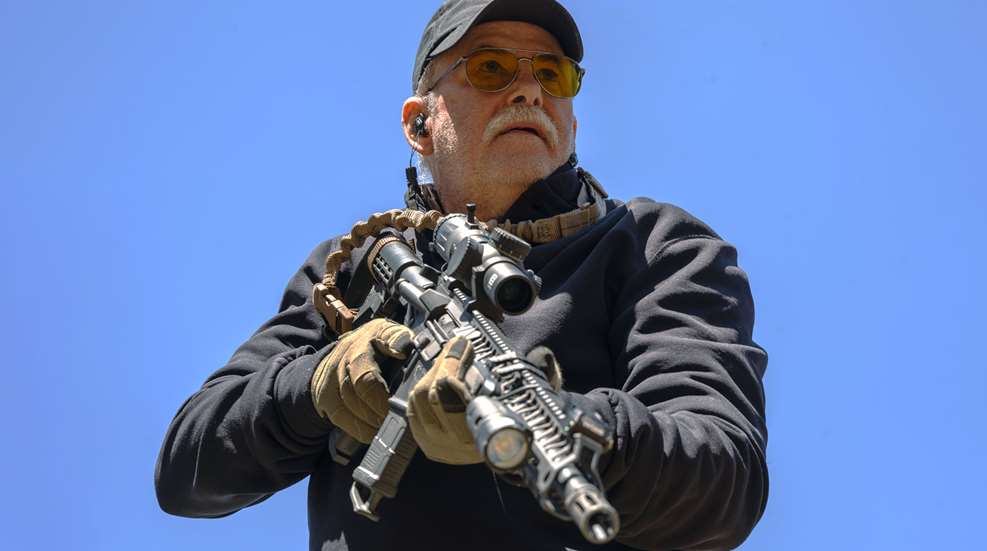
There’s no shortage of optical options for AR-15-style carbines and a short time back I was considering which might be best. More specifically, I was curious about what magnification or magnification range would best compliment an AR-15 with an intended primary purpose of home defense. To make that determination, I conducted a shooting test at what I felt would be a moderate engagement distance, based on where my home is situated and the possible problems that might be encountered there. I was surprised by what I learned.
The test was straightforward: Starting at the low ready, I took my AR-15 chambered in 5.56 NATO and engaged a target at about 55 yards with two shots, as fast as I could get two hits. To help with the magnification, I mounted an EOTech Vudu 1-10x28 mm FFP riflescope I had on hand for testing. I fired two shots at each magnification setting from 1X to 10X, and with the help of a shot timer I recorded the time of the first shot and the second shot. My PACT Club III shot timer also provided the split time (time between shots). I did this three times at each magnification setting. As a side note, the riflescope did not have a setting for 9X, so that magnification level was not tested.
I expected I would shoot faster at the lower magnification settings, but that was not the case. My best performances—the fastest times for both shots—occurred with the magnification set between 6X and 8X. However, my fastest split times (the times between the first and second shot) occurred when the riflescope was set to either 3X or 4X. What this meant was that I was faster on target with the higher magnification, but that I could recover for a follow-up shot faster with less magnification.
Given that I’d discovered the unexpected—conventional wisdom has always suggested engagement times would be faster with less magnification—I felt my experiment was not complete. The question I now had was: Which magnification or magnification range would be best at extreme close quarters and at a greater distance? To get a better understanding of how magnification influences engagement times, I needed to expand the test to include those distances.
Close Quarters
Since it’s not a good idea to shoot steel targets at close range, I set a Thompson Target HALO torso target at 10 yards. The target says it is “life size,” but at only 12 inches wide it’s much closer to the reduced size of the steel Action Target torso target I used at 55 yards. The test I conducted was the same as what was performed on the 55-yard target. Starting at the low ready, I fired two shots at the target as fast as I could get hits, and I used the shot timer to record the times of both shots. As before, I did this three times to get an average.
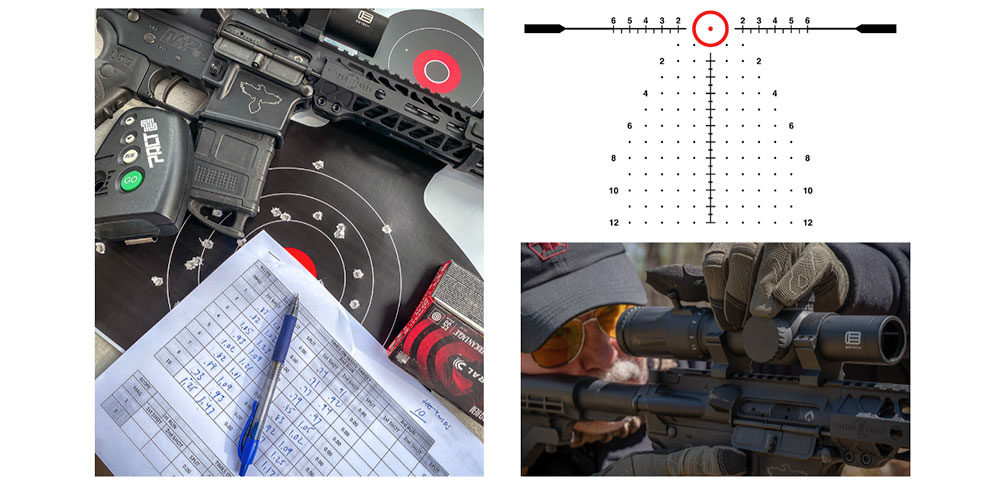
Instead of looking at my performance with a single magnification setting, I looked for trends. In other words, I looked for the best performance over a range of magnification, and I performed the best when the riflescope was set from 1X to 4X. Interestingly, using the same trend evaluation, my fastest split times occurred at the magnification range of 4X to 6X. Admittedly, the difference was negligible. The fastest split time was .17 seconds at 4X, and the slowest was .25 seconds at 10X. That’s less than a tenth of a second difference.
Realizing that snap-shooting a target at 10 yards from the low ready is not particularly difficult, and thinking that because the task was so simple, magnification might not matter that much, I decided to make it more challenging. To do this, I incorporated a turn before the first shot by starting the drill facing at a 90-degree angle to the target. I thought this might make getting the sight on target more difficult at the higher magnification settings. The shot timer showed that I shot the fastest at the 3X to 5X magnification range.
So, for me, depending on the situation, a magnification of 1X to 5X worked best at close quarters. However, I performed so similarly at all magnification settings, the difference was mostly inconsequential.
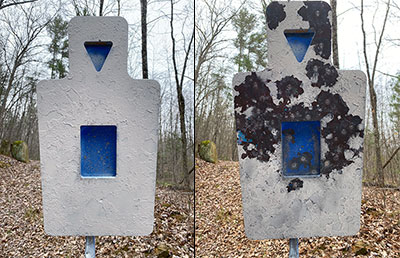
Long Range
Conducting tests like this is, of course, how you learn things and I was eager to see what I might learn at 100 yards. I went back to the Action Target reduced-size steel silhouette and repeated the same sequence as before. I fired two shots at 1X, record the times, fire two shots at 2X, 3X, 4X and so on. After reaching 10X and firing two shots, I started over, running through the full magnification range—two shots at a time—three times.
Of course, the farther away a target is, the harder it is to hit, and the only times I recorded were those where both hits were obtained. This resulted refiring six of the
27 engagements, and most of the engagements where I had a miss were at the lower-magnification settings. My fastest average first shots occurred at 5X and so did my fastest average overall engagement times. My slowest average first shots and engagement times happened at 1X. My fastest split times were obtained at 7X, and the best overall performing range of magnification was between 5X and 7X.
Lessons Learned
It goes without saying that these results are mostly indicative of my shooting and may not accurately apply to others. I should also mention that I was only interested in getting a hit; a hit on the edge of the target counted just as much as one in the center. Had a stepped scoring system that gave advantage to better shots been applied, the results might have been different. Finally, this test represents only 216 impacts on target. Had the number of shots been doubled or had another shooter been incorporated, perhaps the results of my testing would have yielded something different.
One aspect of this test I left out was how an illuminated reticle impacted my shooting. I ran the experiment at each distance three times. The first and last runs were conducted with no illumination, but illumination was used during the second run. This provided a rather telling result. On average, and overall, I shot 4 percent faster when using the illuminated reticle. Granted, concerning sub-3 second engagements, 4 percent is not a lot—about a tenth of a second at most—but every little bit matters, and clearly, the easier-to-see reticle made a difference.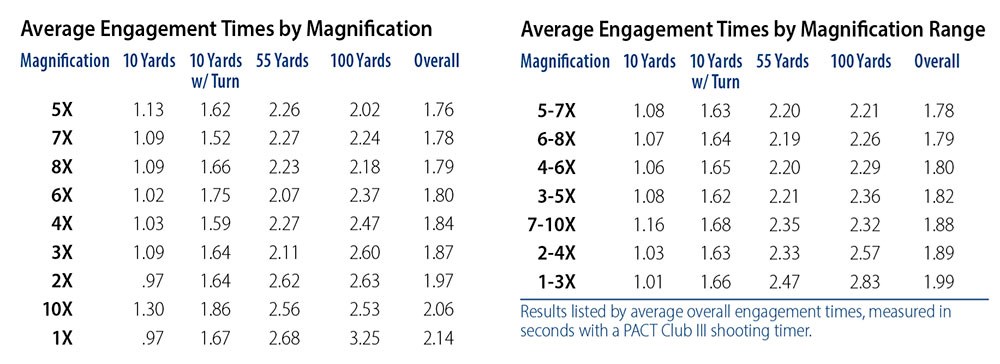
The primary question I wanted to address was what the best single magnification or magnification range for a carbine optic intended to be used for home defense, at distances from 10 yards to 100 yards. Based on the average overall engagement times—the time it took to fire two shots and get two hits at 10, 55, and 100 yards—5X turned out to be the best magnification, while 6X and 8X had the second fastest average times and 7X came in fourth. In fact, 5X, 6X, 7X and 8X, performed very similarly, but there was a noted reduction in performance—increase in engagement times—between these magnification settings and all others.
I think it is also of note that 1X magnification, which is the magnification for most red-dot/holographic/reflex-style sights, delivered the worst overall average performance. This is rather telling, since these types of optics are likely the most popular for self-defense AR-15-style carbines. Magnification at 10X was almost as bad, and without a 9X magnification setting on the EOTech riflescope for comparison, 10X sort of hangs out there on its own. This highlights the rule of extremes as it relates to general-purpose application, while giving credence to the notion that an average of extremes generally delivers the best average performance.
Were I looking for an optical sight for a home-defense carbine, I’d avoid a non-magnifying sight if the possibility of longer shots exists. If I wanted a fixed-power optic, something between 5X and 7X would seem to offer the best balance. But, there’s this preconceived notion in the back of my head called conventional wisdom that says a lesser magnification range such as 3-5X or 4-6X might be better. When looking at a 3-times magnification range, the difference in performance between 3-5X, 4-6X and 5-8X was a mere four hundredths of a second.
Maybe more importantly, what this test really showed was that you’re probably best off with a variable-powered riflescope with a wide magnification range like the EOTech Vudu. This would allow you to tune the magnification to the specific distance and circumstance, based on how you shoot. It would also allow you to do what seems like the most logical thing, and that’s to leave your magnification set at 5X, which will possibly provide you with the overall best performance from 10 yards out to 100.












